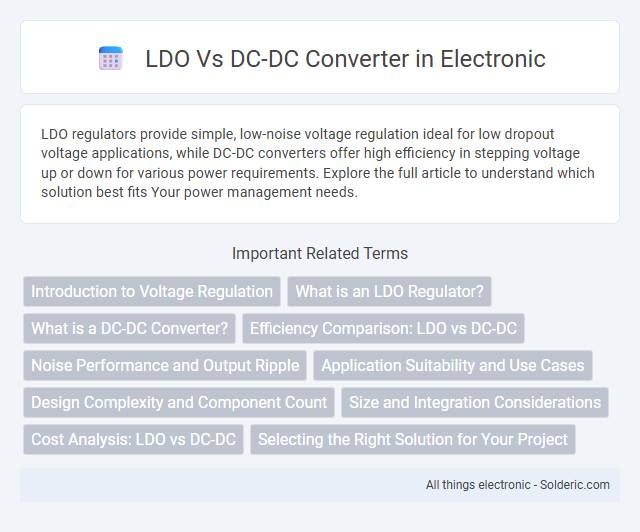LDO regulators provide simple, low-noise voltage regulation ideal for low dropout voltage applications, while DC-DC converters offer high efficiency in stepping voltage up or down for various power requirements. Explore the full article to understand which solution best fits Your power management needs.
Comparison Table
| Feature | LDO (Low Dropout Regulator) | DC-DC Converter |
|---|---|---|
| Function | Linear voltage regulation with low dropout voltage | Switching voltage regulation with high efficiency |
| Efficiency | Typically 40%-60% | Typically 80%-95% |
| Noise | Low output voltage ripple and noise | Higher ripple and switching noise, requires filtering |
| Size & Complexity | Simple, fewer components, smaller size | More complex, requires inductors, capacitors |
| Heat Dissipation | High power loss as heat, needs heat sinking | Lower heat generation due to higher efficiency |
| Input Voltage Range | Input voltage must be slightly higher than output | Wide input voltage range supported |
| Output Voltage | Fixed or adjustable, but always lower than input | Can step-up, step-down, or invert voltage |
| Cost | Lower cost, simpler design | Higher cost due to components and complexity |
| Common Applications | Noise-sensitive analog circuits, low-power devices | Battery-powered systems, efficient power supplies |
Introduction to Voltage Regulation
LDO (Low Dropout Regulator) and DC-DC converters are essential components for voltage regulation in electronic circuits, ensuring stable power supply by maintaining a constant output voltage despite variations in input voltage and load conditions. LDO regulators provide a simple, low-noise solution ideal for small voltage differences and low power applications, while DC-DC converters offer higher efficiency by switching and are suitable for larger voltage drops and high current demands. The choice between LDO and DC-DC depends on factors such as efficiency requirements, heat dissipation, output noise sensitivity, and physical space constraints.
What is an LDO Regulator?
An LDO (Low Dropout) regulator is a type of linear voltage regulator designed to operate with a very small input-to-output voltage difference, known as dropout voltage. It provides a stable, low-noise output voltage by dissipating excess power as heat, making it ideal for applications requiring clean power with minimal ripple, such as sensitive analog circuits. Compared to DC-DC converters, LDOs offer simpler design and lower electromagnetic interference, but are less efficient when the difference between input and output voltages is large.
What is a DC-DC Converter?
A DC-DC converter is an electronic circuit that converts a source of direct current (DC) from one voltage level to another, either stepping up (boost converter), stepping down (buck converter), or inverting the voltage. These converters improve energy efficiency in power management by enabling optimal voltage regulation for electronic devices. Unlike linear regulators such as LDOs, DC-DC converters use switching elements and inductors to achieve higher efficiency, especially in applications requiring significant voltage changes or high current.
Efficiency Comparison: LDO vs DC-DC
DC-DC converters typically offer higher efficiency than LDO regulators, especially when there's a significant difference between input and output voltage. While LDOs provide simpler design and lower noise, their efficiency drops as the voltage drop increases, often resulting in energy loss as heat. Choosing a DC-DC converter can improve your power management by minimizing energy waste and extending battery life in demanding applications.
Noise Performance and Output Ripple
LDO regulators typically provide lower noise performance and reduced output ripple compared to DC-DC converters, making them ideal for sensitive analog and RF circuits. DC-DC converters, while more efficient for large voltage drops, generate higher switching noise that can interfere with noise-critical applications. When your design demands minimal output ripple and superior noise integrity, an LDO is often the preferred choice despite its lower efficiency.
Application Suitability and Use Cases
LDO regulators are ideal for low-noise applications and provide simple, cost-effective voltage regulation in scenarios with small voltage drops and minimal power dissipation, such as in audio devices and sensitive analog circuits. DC-DC converters are suited for applications requiring high efficiency and significant voltage step-up or step-down across a wide input range, commonly used in battery-powered systems, portable electronics, and power management for complex digital circuits. The choice between LDOs and DC-DC converters depends on trade-offs involving power efficiency, thermal management, noise sensitivity, and space constraints inherent to specific electronic device requirements.
Design Complexity and Component Count
LDO regulators feature a simpler design and fewer components, making them ideal for applications with limited space and low power requirements. DC-DC converters involve complex circuitry, including inductors and switching elements, which increases component count but enhances efficiency for high-power designs. Your choice depends on balancing simplicity and efficiency based on the specific power needs of your project.
Size and Integration Considerations
LDO regulators feature a compact design with minimal external components, making them ideal for space-constrained applications requiring simple linear voltage regulation. In contrast, DC-DC converters are generally larger due to the need for inductors, capacitors, and more complex circuitry, but they offer higher efficiency and better thermal performance in power-intensive designs. Integration of DC-DC converters often involves specialized integrated circuits and more board space compared to the smaller, easier-to-integrate LDOs, influencing the choice based on system size and power requirements.
Cost Analysis: LDO vs DC-DC
LDO regulators typically offer lower upfront costs due to simpler design and fewer components compared to DC-DC converters. DC-DC converters, while initially more expensive, provide higher efficiency that can reduce long-term energy costs and thermal management expenses. Your choice between LDO and DC-DC should balance initial budget constraints against potential savings in power efficiency and heat dissipation.
Selecting the Right Solution for Your Project
Choosing between an LDO (Low Dropout Regulator) and a DC-DC converter depends on efficiency requirements and noise sensitivity in your project. LDOs offer simple design and low noise, ideal for low power and noise-sensitive applications, while DC-DC converters provide higher efficiency and better thermal performance in high current situations. Evaluating power consumption, input voltage range, and output voltage stability ensures optimal selection for your specific circuit design.
LDO vs DC-DC Converter Infographic

 solderic.com
solderic.com